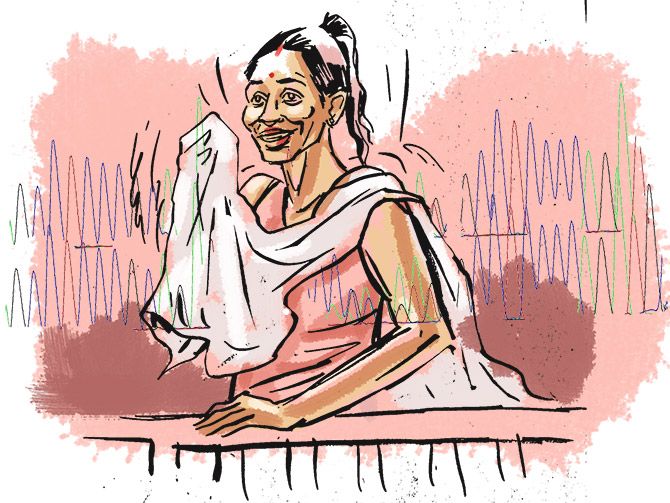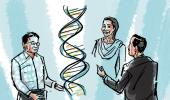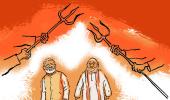Indrani was cheering Pasbola on from the back, with little, happy whoops, that she muffled with her chunni.
Indrani was in her element on Friday. The defence's cross-examination was clearly going her way and Indrani was delighted.
Vaihayasi Pande Daniel reports from the Sheena Bora murder trial.
Illustration: Dominic Xavier/Rediff.com

A walk up the stairs of the Mumbai city civil and sessions court building, opposite south Mumbai's Oval Maidan, floor by floor, is like taking your emotions on a stop-start-stop, bumpity, Indian train ride. Your feelings are always in a state of suspense.
On Friday, December 13, 2019 on the first floor, where the courtrooms that deal with narcotics cases are located, a tall, resigned woman, in a long blue kaftan, her head wrapped in a red and black chunni, was quietly weeping. Huge tears rolled down her pretty face that she was mopping away with the corner her chunni. Her husband wearing a light pink T-shirt and blue pants, was standing by her side trying to comfort her with a few softly-spoken words. A cop hovered behind them.
On the third floor two cute, young boys were squealing in delight as they raced up the stairs. A day's outing at the dull, dreary, court was for them a day of special excitement. Maybe they would be meeting a parent, who was in jail, that they had not seen for long.
Another cocktail of emotions was erupting in CBI Special Judge Jayendra Chandrasen Jagdale's Courtroom 51. A short, bespectacled man, an accused, wearing a bright white shirt and black trousers, his hands folded together in prayer was crying loudly -- dry, harsh, male sobs. His lawyers pleaded with the judge that he had two children, a wife and elderly parents to support and could not afford to go behind bars.
Judge Jagdale, his face like thunder, was scolding his lawyers.
It turned out the accused, allegedly involved in some sort of stock scam, had already been arrested that morning. But his lawyers had foolishly applied for a cancellation of his warrant, which is procedurally seriously incorrect. Further, the accused had not presented himself in court for a number of scheduled dates earlier to his arrest.
After ticking them off -- the accused and the lawyers -- several times over and threatening to write an adverse order, Judge Jagdale relented and granted him bail.
For those of us who have us who have never entered a court building it is hard to find empathy for alleged criminals. One reads in the newspaper factual, bare-bones reports about different types of criminal cases. Those reports don't make one find space in one's heart for the accused arrested for the crimes you read about.
But when you come face to face with all varieties of criminals, many of them petty criminals, at the courts, before your eyes, the criminal loses his criminal tag. He once again is also a human being, a flawed one, maybe, at that.
Probably someone with a wife and little children.
Probably someone who is awfully poor.
Probably someone whose unfortunate and means-less family will bear the major burden of his journey behind bars.
Probably someone with a lot of bad luck.
Probably someone who will serve a much greater sentence than his crime and never again have a life.
Probably someone who may not even be guilty for the crime he is charged for.
And your perspectives of alleged criminals and criminals slowly changes with time.
After nearly three years of coming to court, it is impossible not to have immense empathy for this most neglected lot of India's untouchables, that fall between the cracks of our system.
An accused, who I was chatting with on Friday, told me that the overpacked Arthur Road jail, central Mumbai (some 3,500 plus prisoners live there, at last count, in a space meant for 1,000; Mumbai prisons are some 102% over capacity) is overflowing with hordes and hordes of accused who have not even sought bail ever.
Why?
Because they cannot afford bail.
Because they prefer to live in jail rather than on the streets. At least in jail, even if unhygienic, you get a few square meals, there is a mattress, a fan, shelter from harsher weather and a bathroom of some kind.
Because even if they got bail where would they go? Who would hire them, who would support them, who would want them and how would they live?
At least as whatever Prisoner Number 3245 or maybe 1345 they have an identity, the companionship of others in the same situation -- and a smidgeon of dignity .
Because those who have got bail have not yet left because the rehabilitation process to get them back into society, aided by a few very worthy NGOs, is very slow.
Because there are families who have dumped a member in jail, on some pretext or another, because they don't want to take care of them, like a 94-year-old man, now nearly incontinent and mentally incapable, who is taken care of by inmates at Arthur Road jail.
These kinds of stories can only tug at your heart strings, tales of the most unfortunate, India's Les Miserables. How can your perspective not change?
Friday was Day 3 of the cross examination of Prosecution Witness 59, Shrikant Hanumant Lade in the Sheena Bora murder trial at Courtroom 51.
Day 2 on Wednesday, December 11, went by in a blur of two hours of intense and pure biology, specifically the study of DNA. Indrani's lawyer Sudeep Ratnamberdutt Pasbola laid the grounds and educated the court on the background on Wednesday for what he planned to tackle Friday.
Lade, who once worked at the Forensic Science Laboratory, Kalina, north west Mumbai, had conducted the DNA tests on the remains of Sheena, found at Gagode Khurd village, Raigad district, and linked them to the DNA in the blood sample of Indrani Mukerjea, Accused No 1.
The hearing on Friday began with a bit more DNA study before it zoomed in on the crucial five electropherograms.
An electropherogram, which looks like a chart of mini ECGs, is used in the discipline of genetics. It plots the DNA fragment sizes and provides the DNA sequencing. The electropherograms are generated by an automated DNA sequencer.
Of course, Pasbola, probably after many days of study and seeking advice from experts, aided by his assistant, the capable and sturdy Gunjan Mangla, knew electropherograms inside out.
He confessed to the judge that Mangla would keep showing up every evening with taller and wobblier stacks of more and more books and papers to read to expand their study, much of which was online too.
If it is indeed a lawyer's job is to convert himself overnight into an expert in a certain discipline, that is central to a case he is working on, he has to also become an expert who knows much more than the actual expert in the witness stand, to best him, in a courtroom battle of wits.
That Pasbola is rather good at.
The five electropherograms under examination and dissection on Friday were of the DNA from blood samples of Indrani Mukerjea, her son Mekhail Bora, the Mukherjeas's driver and Accused No 3 Shyamvar Pinturam Rai and the DNA of the sample of femur and vertebrae obtained from the half-burnt corpse, said to be Sheena's, from Raigad.
Mekhail and Rai's electropherograms were not given much discussion time, however.
For links in DNA to be proved between one individual and another, values on their electropherograms must also match.
Pasbola laboriously went through each chart before the court. He had nothing to query Lade about when it came Indrani's DNA electropherogram.
Peculiar and highly unusual complications arose when it came to the charts associated with DNA extracted from the corpse's femur and vertebrae.
A machine had generated each of these electropherograms, but both in the case of the femur and the vertebra, Lade had pencilled in certain values by hand.
Pasbola called out each of these handwritten values, one by one, for each graph on each chart, asking Lade why they had been written by hand, what was the reason, when were the corrections by hand done and had they been done by him.
Lade acknowledged he had made the corrections himself each time.
He didn't remember when he had pencilled in the corrections.
He said it was because the numerical values had been cut off while taking a print out. At other times he stated it was because the machine had not generated a value so he had supplied it.
He also told the court that if you actually went to his machine that generated the chart, that value, that he had written in by hand, was there in the machine. Yet he had not brought any documentary proof that the values he pencilled in were completely legitimate.
Here is a sample of the to and fro that occurred, in heavily technical forensic science language, between a rather unruffled, unbothered Lade and a genetically and mathematically precise Pasbola:
Pasbola: "Please see 683/3 (for the femur bone)... Now as far as the last STR* marker, of the first window, CSF1PO the machine indicated only one allele** marker as 10. The machine has not produced the other. The 12 (added by hand) is not recognised by the machine?"
Lade: "Yes."
Pasbola: "(The value) 12 was included by hand."
Lade: "Yes sir..."
Pasbola: "Please see the third window. As far as the STR marked D18S51 the machine has reproduced only one peak."
Lade: "I have added 18 in my handwriting..."
Pasbola: "Now please see 683/4(for the vertebra). In the second window STR loci D3S1358 the machine has recorded an allele at 16,7. You have corrected the 16 to a 19?"
Lade: "Yes."
As Pasbola tediously pointed out each hand-corrected value and questioned Lade on his reason for writing in the value by hand, Indrani was cheering Pasbola on from the back, with little, happy whoops, that she muffled with her chunni.
Wearing a peachy, sleeveless chikan kurta, matched with a white cotton chunni and churidar and brown juttis, Indrani was in her element on Friday. The defence's cross-examination was clearly going her way and Indrani was delighted.
Every time Lade acknowledged he had written in a DNA value by hand, Indrani would let out a laugh or a giggle, big broad smiles were writ large on her face. Excitement somersaulted in her eyes.
At one point she burst out of the rear accused enclosure, with the judge's faintly amused permission, to come forward and show Pasbola and Mangla yet another instance of pencilling in.
The fact that Lade had written in certain values by hand is critical in this case because:
1. There is no reason why he should have done this in the normal course of events. A machine is meant to generate all the values.
2. Did he pencil in values so that that the values on the charts for the DNA extracted from femur and vertebra from Sheena's remains should match the DNA values obtained from Indrani's blood sample?
When Pasbola concluded his cross-examination for the day at 2 pm on Friday, citing some urgent work at the high court, and asked permission to continue the cross-examination on Monday, December 16, he had not yet grilled Lade on the actual reason for correcting or perhaps as the direction of his 'cross' is suggesting, 'doctoring' the DNA electropherograms by hand. Nor had he levelled any charges.
That exciting drama (of lots of probably tu-tu mein-meins) will unfold, no doubt, on Monday.
Pasbola, a seasoned lawyer who has dealt with many cases that involved DNA evidence and electropherograms, did say emphatically and categorically that in all his years in court he had "never" before seen electropherograms with values "written by hand."
Indrani, in a happy mood, sailed out of court on Friday, headed back to jail.
There was no word on her bail application.
Peter Mukerjea, who apparently likes the leisure of a train journey, will not be in court on Monday because he is headed to Delhi by the Rajdhani on that day.
As the court emptied out, a largely-built woman, wearing a colourful sari trundled up to the court entrance, trailed by her husband. She wanted to know if there was a separate courtroom or area for "aurat (female)" cases.
She was trying to find the courtroom where her son's case was being heard. The lawyer they had engaged had given her the court address and not the courtroom number. Finding the right courtroom among over 50-60 courtrooms can prove to be a maze for a newcomer at court.
It turned out her she was the mother of Raj Raju Waghela. Her son had been charged with rape and had been arrested two months before by the Sewri police station, central Mumbai. December 13 was the first hearing in the case.
She said he had gone out with some friends and "kuch hua", but she was fairly certain her son had not been involved in any misdoing. Her son had not been produced in court on Friday and she didn't know why.
A helpful colleague pulled out the courtroom number and case number from the e-court site. She and Waghmare, the senior peon attached to Courtroom 51, who after years spent in court can, like a lawyer, recognise types of offences by the offence number, guided Raj's mother in the right direction to Courtroom 39 of Judge Shrimati N T Ghadge.
As Mrs Waghela set off, her husband still trailing her, your mind wandered back to its earlier theme.
You wondered what would eventually happen to this faceless Raj. Would he get bail? Was he guilty? For how many years would the luckless and not particularly well-off Waghelas, for whom a son's crime becomes their hard-to-wield burden in India, as the same colleague pointed out, be making trips to Courtroom 39?
* stands for short tandem repeat and is a pattern of two or more nucleotides that are repeated directly adjacent to each other in a DNA sequence.
** gene variant form.
Vaihayasi Pande Daniel covers the Sheena Bora Murder Trial for Rediff.com.
You can read her fascinating coverage here.










